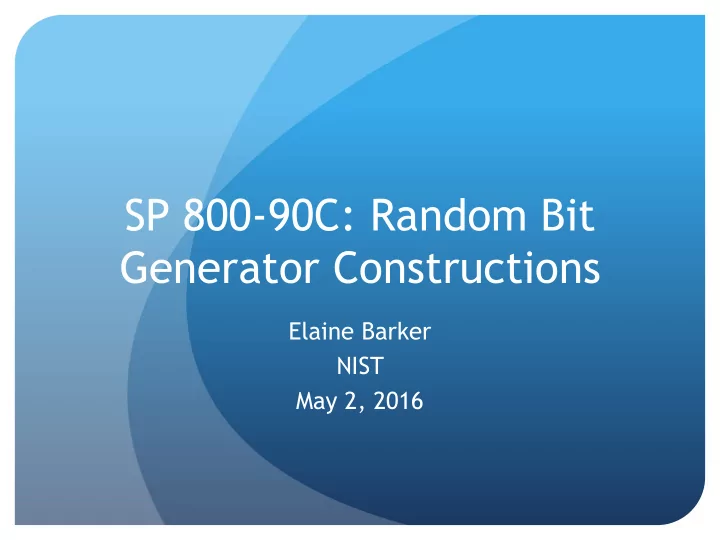

SP 800-90C: Random Bit Generator Constructions Elaine Barker NIST May 2, 2016
2 Purpose of 800-90C: To construct RBGs from approved entropy sources (see SP 800-90B) and DRBG mechanisms (see SP 800-90A) o DRBGs (a.k.a. pseudorandom number generators) o NRBGs (a.k.a. true random number generators) To specify health and validation testing requirements
3 Assumptions (see Section 4.2) : Each entropy source output has a fixed length and a fixed amount of entropy Entropy source outputs from the same source or multiple independent sources can be concatenated and the entropy added Entropy sources can provide indications of successes and failures Entropy source output can be conditioned to reduce bias or condense into a shorter bitstring Vetted conditioning functions can provide full-entropy output if entopy_in ≥ 2 × min ( narrowest_internal_width , output_length ); Note: for the vetted conditioning functions, narrowest_internal_width = output_length SP 800-90A DRBG mechanisms meet their security claims (e.g., claimed security strengths)
4 Definitions Backtracking Resistance: Knowledge of the state at time T cannot be used to determine states prior to time T Prediction Resistance: The insertion of fresh entropy at time T disallows determining the state at time T and T + i when any state prior to time T is known T T-i T+i Prediction resistance Backing resistance
5 Definitions (contd.) Secure channel: A data path that ensures confidentiality, integrity, replay protection and mutual authentication Full entropy: Every bit of a bitstring has one bit of entropy; entropy_in ≥ 2 n, where n is the size of the output
6 RBG Concepts: • Single and distributed boundaries (conceptual) RBG within A Single Cryptomodule: Cryptographic Module Boundary
7 Distributed RBG over Multiple Cryptomodules
8 Concepts (contd.): • Randomness source - Entropy source, RBG (DRBG or NRBG) or chain of RBGs • Live Entropy Source: available when needed • External conditioning on entropy-source output using vetted functions • Prediction resistance: obtain fresh entropy from an entropy source (using a reseed capability) • (Enhanced) NRBG (i.e., DRBG mechanism provided as a fallback)
9 DRBG Randomness Sources: Randomness source only required for instantiation Live entropy source allows prediction resistance Reseed from any randomness source
10 DRBG Chain: DRBG Chain … DRBG DRBG DRBG Entropy Random. Random. Mechanism Mechanism Mechanism Source Source Source RBG 1 RBG n-1 RBG n
11 Which Randomness Sources? Purpose Provide Instantiate Reseed Provide prediction Randomness NRBG Target Target resistance from Source output DRBG DRBG Target DRBG Entropy Source Yes Yes Yes Yes NRBG* --- Yes Yes Yes DRBG (live entropy source --- Yes Yes Yes available) DRBG (NO live entropy source --- Yes Yes No available) * Includes an entropy source
12 DRBG Capabilities, Given the Availability of a Randomness Source: Randomness Live Source Entropy Comments Availability Source? When Yes The randomness source is an entropy source, an required NRBG, or a source DRBG with access to a Live Entropy Source. A DRBG can be instantiated, generate bits, be reseeded, and provide prediction resistance. When No The randomness source is a source DRBG with no required access to a Live Entropy Source. A DRBG can be instantiated, generate bits, and be reseeded, but cannot provide prediction resistance. During No The randomness source is an entropy source, an instant. only NRBG, or a source DRBG with or without access to a Live Entropy Source. A DRBG can be instantiated and generate bits, but cannot be reseeded or provide prediction resistance.
13 NRBGs: Two constructions: XOR and Oversampling Live Entropy Source always required and used Approved DRBG mechanism required for the (enhanced) NRBG o Instantiated at the highest security strength possible o Fallback if an undetected entropy source failure o DRBG can be accessed directly (same or different instantiation) Provides full-entropy output Backtracking and prediction resistance always provided
14 NRBGs: XOR Construction Requires full entropy (on the left side of the figure) External conditioning required if entropy source does not provide full entropy output (i.e., not optional in this case)
15 NRBGs: Oversampling Construction Entropy source need not provide full entropy output External conditioning can reduce entropy source bias, shorten entropy source output or provide full entropy, if desired
16 Additional Constructions: Get_entropy_input specifications to access randomness sources: o Using a DRBG (with and without a prediction resistance capability) o Using an NRBG o Using an entropy source The Get_Entropy call (i.e., interface with the entropy source capability); includes condensing constructions With and without external conditioning Obtain full-entropy output from a DRBG with prediction resistance
17 Other Stuff: Combining RBGs: At least one must be approved Health testing o At startup and on-demand (entropy sources also have continuous tests) o Test whatever components are available o Enter an error state when an error is reported Notify the consuming application Consuming application then responsible for handling the error (e.g., request user guidance or prevent further RBG requests)
18 Other stuff (contd.): Implementation Validation o Validate 90A and 90B components o Validate 90C constructions (e.g., conditioning functions) o Documentation requirements (e.g., DRBG or NRBG, features supported, if the RBG is distributed) Examples: o XOR-NRBG o Oversampling NRBG o DRBG without a Randomness Source (after instantiation) o DRBG with a Live Entropy Source
19 SP 800-90C Availability SP 800-90C available for public comment at http://csrc.nist.gov/publications/PubsDrafts.html#SP- 800-90-C. Comments requested by June 13, 2016. Send comments to rbg_comments@nist.gov, with “Comments on Draft SP 800- 90C” on the subject line.
20 Questions? Note that further RBG discussions will be held at the end of the workshop on Tuesday.
Recommend
More recommend